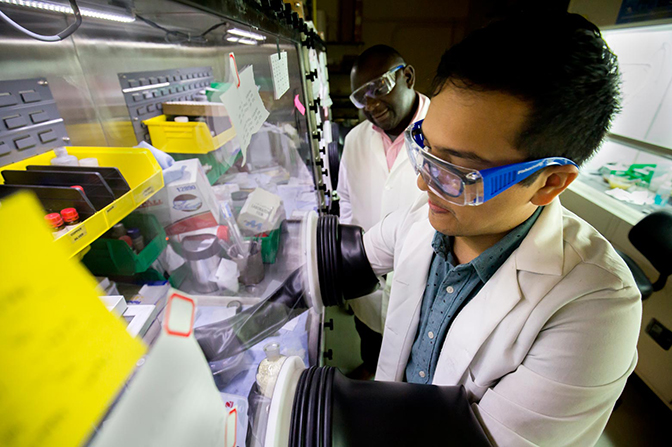
Turning waste heat into emissions-free electricity
Energy-intensive industries have been waiting for a low-cost, low-toxicity thermoelectric generation material. It’s here.

Energy-intensive industries have been waiting for a low-cost, low-toxicity thermoelectric generation material. It’s here.

A long-sought chemical cocktail developed by University of Michigan materials science researchers could turn waste heat in some of the world’s most energy-hungry industries into a new source of emissions-free electricity.
While the compound could be used in cars and to power small household devices, the researchers expect it to have the biggest impact in sectors like steel, glass and cement manufacturing. They account for about a third of industrial power usage, and today, much of that energy is simply lost to the atmosphere as heat.
Applied to a hot pipe in a glass factory or metal processing plant, the new material begins pumping out electricity when exposed to about half as much heat as previous thermoelectric generators. It’s also less toxic and much less expensive than its counterparts.
“Energy-intensive industries have been waiting for a low-cost, low-toxicity thermoelectric generation material,” said Pierre F. Poudeu, a U-M associate professor of materials science and engineering. “They already have applications waiting, so I think this will go into use very quickly.”

A mix of copper, selenium and indium, the new compound is the first stable copper selenide material that can turn waste heat into electricity.
Researchers have known for years that copper selenide can generate electricity from heat because of a principle known as the Seebeck Effect. When one side of a thermoelectric material is heated, electrons move away from the hot end toward the cool end, creating an electric current. But in order for thermoelectric generators to continue working, the hot side has to stay hot while the cool side stays cool. So materials with high electrical conductivity but low heat conductivity work well.
Copper selenide fits the bill, and it works far better than today’s thermoelectric compounds, which are expensive, inefficient and made of toxic materials like lead. But copper selenide has historically had one big shortcoming.
“It stays together just long enough for us to measure its impressive thermoelectric efficiency, and then turns into a useless blob,” Poudeu said. “Copper selenide generates electricity most efficiently at about 1,340 degrees Fahrenheit, but when it reaches about 260 degrees, the copper begins to ooze out like Playdoh. This is because the copper atoms in the compound have a lot of room to move around in the lattice structure. That’s good for electricity generation, but bad for high-temperature stability.”
Poudeu’s graduate researcher, Alan Olvera, proposed a solution. He hypothesized that filling some of the empty space in the atomic lattice structure with indium nanoparticles would give the copper atoms less room to move, making the compound more stable at high temperatures. So the team milled the copper, selenium and indium together, making a powder that they then compressed into pellets in a furnace.
Tests proved that the compound stayed stable under high temperature and intensive electrical generation. And the team was surprised to discover that it was even less thermally conductive and more electrically efficient than the copper selenide that had been used previously, enabling it to generate electricity at still lower temperatures.
“Copper atoms conduct heat by vibrating, and when we add indium, the copper atoms can’t vibrate as easily.” said Olvera. “When the copper atoms are localized in one place, electrons are able to move more freely, producing more electricity. So we get a material that’s more stable, less thermally conductive and more electrically conductive.”
Earlier iterations of thermodynamic generators are already in use in a few industrial applications, and Poudeu says the new compound could be used in many of those places immediately—it’s simply a matter of replacing one material with another. The new compound could also lead to wider use of thermoelectric generation in industry, as well as their use as auxiliary generators in cars and to power small household items like cell phones.
Poudeu’s team is working to commercialize the technology, either by licensing it to a manufacturer with the assistance of the U-M Office of Technology Transfer or by manufacturing it directly through Suematek, LLC, a startup he founded.
The new material is detailed in a paper published in the July 1, 2017 issue of Energy & Environmental Science. The paper is titled “Partial indium solubility induces chemical stability and colossal thermoelectric figure of merit in Cu2Se.” The research was supported by the Department of Energy, Office of Basic Energy Science under award DE-SC-0008574 and the U-M MCubed program.